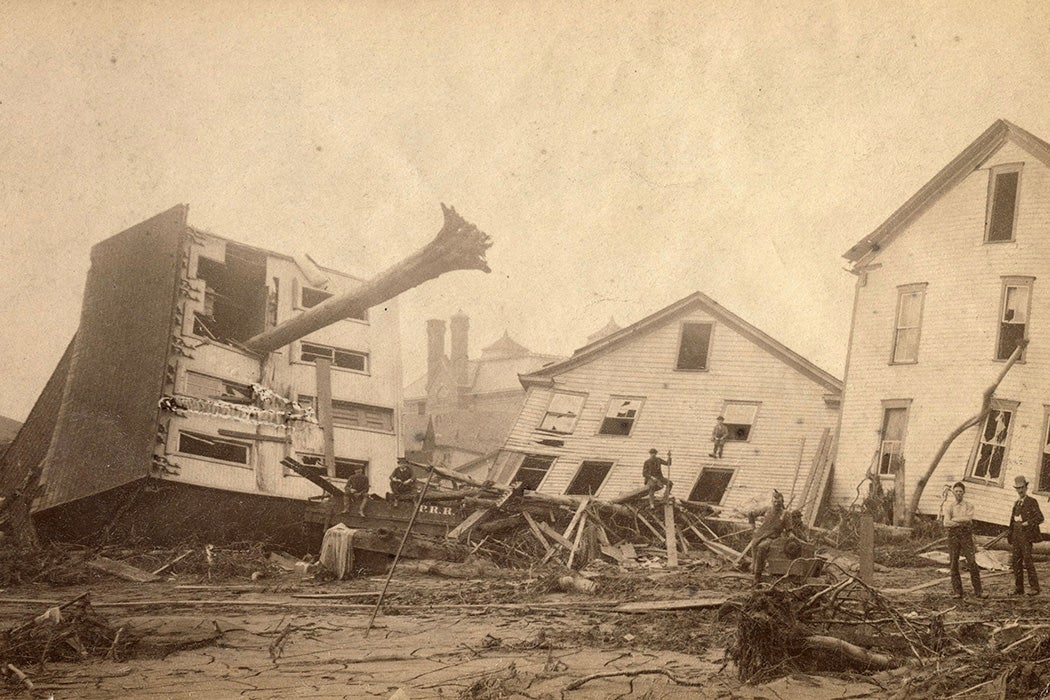On May 31, 1889, a dam fourteen miles upstream from the industrial center of Johnstown, Pennsylvania, collapsed. A massive rain storm had swollen the artificial lake behind the dam, which had been created for the South Fork Fishing and Hunting Club by Pittsburgh robber barons including Andrew Carnegie, Henry Clay Frick, and Andrew Mellon. When the shoddily constructed dam, patched with straw, burst, an estimated 14 million cubic meters of water roared downstream. More than 2,200 people were killed by the inundation. More than 750 of these were buried in the town’s Unknown Plot.
The Johnstown Flood was one of the greatest disasters of the nineteenth century. And within days, the devastation became a tourist attraction. Scholar Emily Godbey explores how “rubbernecking” leisure fit into the late nineteenth-century search for encounters with the “authentic and the real.”
Newspapers and relief workers were soon complaining about sightseers filling the trains heading towards the wreckage. “Please Keep Away” headlined the Pittsburgh Commercial Gazette. They did not. Bodies were still being pulled out of the water when, as early as June 16,
the B&O Railroad was selling round-trip excursion tickets for $2.35 to allow tourists to see the town for four hours. The railroad sagely advised the rubberneckers, “Those who desire to go on this excursion should provide themselves with lunch baskets as provision cannot be procured at Johnstown.
Souvenirs were extremely popular, with people picking things up to take home. There may have been some robbing of bodies—Godbey notes that the sensationalism of press coverage clouds what actually happened. Many of the souvenirs were found objects, but enterprising “relic cranks” sold “broken china, piano keys, beer bottles, horseshoes, buttons, bits of brick or wood shingles.” Buttons were very popular.
Amateur “camera fiends” swarmed the area, many armed with the Kodak box camera introduced just the year before. The Schultz House, on its side with a tree stuck through it, was a popular photo spot—men and boys lined up on the tree trunk suspended in the air. Professional photographers also showed up in large numbers. The Library of Congress has many versions of photographic sets of the ruins deposited for copyright. For visitors and distant armchair tourists, stenographic views and albums of images were highly popular. Clara Barton, who headed Red Cross relief efforts at Johnstown, had a substantial collection of Johnstown photographs, including ones commissioned by the Red Cross itself.
With publications like The Johnstown Horror!!! (three exclamation points, and a further come-on: “Fully Illustrated”) and stereographs of children’s bodies captioned “The Johnstown Calamity: Somebody’s Darling—Unclaimed—Unknown,” the aftermath of the flood was an example of what’s now called tragedy, disaster, dark, thana-, or death tourism. Or disaster porn: visiting the Johnston morgue was a highlight of excursionists, some of whom tried to get in “under pretense of searching for friends.” Noting that bodies were typically naked, the press fed the voyeurism, announcing that “there are a number of beautiful girls and children among the corpses.”
Most of what the tourists saw was quite real. Only later would the flood be turned into the entertaining spectacle of theater and side-show. The Johnstown Flood concession at the 1901 Pan-American Exposition in Buffalo was a hot ticket. In 1903, the New York Times proclaimed Coney Island’s Johnstown Flood show the “most powerful illusion” at the amusement center.
Weekly Newsletter
But before it was staged, it could be seen “as a form of live theater—specifically late-century melodrama—where the thrill was based on reality’s nearness.” Melodramas thrived on catastrophe, including “shipwrecks, explosions, fires, avalanches, and earthquakes.” The story of Pompeii’s destruction by volcano was particularly popular. “Machines and sets—instead of actors—were the real headliners,” as was the distinct possibility that the stagecraft effects would injure performers.
“In nineteenth-century America,” Godbey writes, “while the popularly-priced theater might have blood and thunder melodrama on stage, the thrilling theater of real disaster was also available for the price of a train ticket to the stricken district—or for free at the morgue.”
Godbey points to bus tours of Hurricane Katrina damage as an example of contemporary post-disaster tourism. Nineteen years after New Orleans was devastated, such tours are still offered.
Support JSTOR Daily! Join our membership program on Patreon today.







